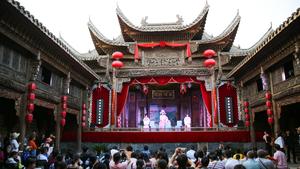 Locals and visitors from around the country enjoy a Huagu Opera performance at a theater in the old town of Tongguanyao in Changsha, Hunan province. (ZENG YONG / FOR CHINA DAILY)
Locals and visitors from around the country enjoy a Huagu Opera performance at a theater in the old town of Tongguanyao in Changsha, Hunan province. (ZENG YONG / FOR CHINA DAILY)
A mobile game, The Novel Coronavirus War of Nuo Gods, has become popular among young people in Hunan province during the pandemic.
Its concept is inspired by the Nuo culture of Hunan province, and it features the performance of ancient rituals to dispel evil and pray for good luck.
Five college students in Changsha, capital of Hunan, designed and developed the game, combining intangible cultural heritage with modern creativity. In the game, players accumulate energy by walking outside to fight enemies.
The game is designed to help players learn about Nuo culture in an entertaining way and to promote the concept of removing ill fortune and fighting COVID-19.
Many innovators in Changsha have integrated modern ingenuity and traditional culture, helping to popularize intangible cultural heritage as well as also improving modern people's lives, according to local media
The students are among many innovators in Changsha that integrate modern ingenuity and traditional culture, helping to popularize intangible cultural heritage as well as also improving modern people's lives, local media reported.
ALSO READ: Crafting a revival
The city's Yuhua intangible cultural heritage pavilion is home to many such products. The 50,000-square-meter venue hosts more than 300 forms of intangible cultural heritage and more than 200 inheritors work there.
It has developed more than 10,000 culturally creative products, such as linen-made table lamps and ceramic excavator models. Hunan bamboo handicraft was integrated into the design of calculators, computer mice and keyboards, while the brocade of the Tujia ethnic group and blue cloth with white designs from Shaoyao city in Hunan have been used to make bedding. Additionally, woodblock pictures from the city's Nuotou town have been printed on mobile phone cases.
Chen Jian, associate professor at the college of engineering and design of Hunan Normal University, said: "More people like intangible cultural heritage and traditional things, but some do not prefer the pattern of representation."
Modern design ideas can work as a communication bridge between such heritage and modern people, Chen said.
READ MORE: Changsha embraces a creative approach to development
Tongguan is an ancient town on the eastern bank of the Xiangjiang River in Changsha. At its zenith, during the period between the Tang Dynasty (618-907) and the Five Dynasties and Ten Kingdoms (907-960), the Tongguan Porcelain Kiln was one of the country's most famous ceramic producers.
At a Tongguan kiln ceramic culture pavilion in the city, domestic and foreign tourists can try their hand at designing and making pottery. A ceramic product created at the pavilion has won the China Arts and Crafts Award.
Chen Guo, among the creators of the award-winning product, said: "Our design and production inherited and developed the style of Tongguan Porcelain Kiln in aspects such as glazing color, decoration and cultural denotation and adapted them to fit modern aesthetic tastes."


